Hillsboro, Oregon
Back to the Northwest Theatre Organ Builders page
The following is an excerpt from an article written by Bill Peterson in Theatre Organ, Winter 1963-64 (V5, No4, pp28-30).
The William Wood Pipe Organ Company
 Partial Wood opus list
Partial Wood opus list
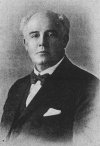
William Wood |
Available history indicates that the William Wood Pipe Organ Company was born in Portland, Oregon, in the year 1922. The officers who served the company throughout its existence were William Wood, president; George A. Morrison, vice president; and Edward E. Juster, secretary. Several locations were used by the firm during its history.
In 1925 the company was located on the west side of Portland at 101 13th Street. The company moved to much larger quarters in 1926, taking over the second floor of a manufacturing plant at 1475 East 27th Street North, corner of Morgan. |
|
Although street numbering in Portland has since been changed, the factory, with its large "CHAMPION MANUFACTURING COMPANY" sign on the roof, stood proudly in the middle of what is now Northeast Lombard Street (at N.E. 27th Avenue) on the south side of the Union Pacific Railroad tracks. The railroad siding "CHAMP," which serviced the factory and its steam plant and dry kilns, is still there for those of us who like to reminisce. |
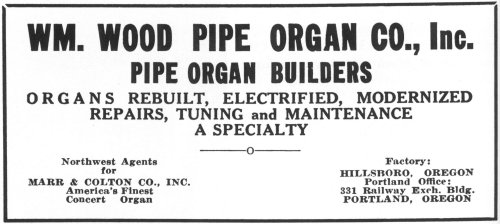
Ad from the December 1924 Diapason magazine |
"Billy" Wood, as his friends and coworkers knew him, was a man of rare attributes. His genius for electrical mechanics, his profound knowledge of music and musical instruments, and his devotion to perfection in the building of pipe organs endeared him to all who knew him. His musical education apparently began very early in his life, for it is known that he and his brother Darwin, both of tender age, played a duet on pipe organ and piano before Her Majesty, The Queen of England! Thus, "Billy" took an early step in a career which led him to build many fine pipe organs and carve a niche in the musical history of the Pacific Northwest.
During the early days of the Silent Screen, the Jensen and Von Herberg theatre chain installed many fine organs in their theatres, and for a time William Wood was their service man for these organs in the Portland area. Most of these organs were WurliTzers, and included the 4/32 Hope-Jones WurliTzer (Opus 164) in the Portland Liberty Theatre. During this time "Billy" maintained a Marr & Colton theatre organ in suburban Forest Grove, Oregon. Since the pipe organs which he later built contained similar chestwork, there is no doubt that "Billy" was influenced by Marr & Colton in his own designs.
Most of the wooden pipes used in a "William Wood" organ were made in their own factory, a great many of them by the founder himself. Wood designed his own "scales" for the wooden pipe work and his "Tibia Clausa" of special scale is something to hear! In the 16 foot register, his wooden "Violone" and "Double Open Diapason" ask no quarter. To his specifications of wind pressure, scale, and voicing, all metal pipe work was purchased from Anton Gottfried and Son, Erie, Pennsylvania. Musical percussions, of appropriate scale, were purchased from J. C. Deagan, Inc., Chicago, Illinois, and the electric magnets from Reisner Manufacturing Company, Hagerstown, Maryland.
The company's most popular organ model, both musically and price-wise, seems to have been the 2/8 with a horseshoe console:
| MAIN, OR LEFT CHAMBER |
SOLO, OR RIGHT CHAMBER |
| Flute 16' to 1-3/5' |
Tuba Profunda 8', 4' |
| Open Diapason 8', 4' |
Tibia Ciausa 8', 4' |
| Viol d'Orchestra 8', 4', 2' |
Vox Humana 8', 4' |
| Viole Celeste 8', 4' |
Usual traps, drums, bells, etc.
| Clarinet 8', 4' |
Piano (if ordered) |
| Metal bar Harp (if ordered) |
|
|
At customer request, the Clarinet in the MAIN was exchanged for a French Horn, Orchestral Oboe or Krumet. Theatre acoustics (with people) determined the final wind pressures used. The consoles were equipped with two swell pedals and usually a crescendo pedal. Three tremulants were standard: Solo, Main, and Vox Humana.
Perhaps one of the company's better sounding organs was the 3/9 (with piano) installed in Gellers (now the Aladdin) Theatre near the intersection of Powell Blvd. and Milwaukee Avenue, Portland. The "brassiest," no doubt, was the Special 2/8 installed for Chris Jeffries at the Imperial Roller Rink, Portland. The largest was surely the 4/13 installed for Bob Bollinger in the Roller Rink at The Oaks Amusement Park on the beautiful Willamette River near Portland. This organ was originally installed as a 2/5 Special but was enlarged set by set, right at the-skating rink, to its eventual 4/13 size.
"Billy" Wood and his brother Darwin, "The Professor," were both accomplished musicians, and both were employed as organists at various Portland theatres. However, "Billy" devoted the
major portion of his talents to the building of pipe organs while "The Professor" became very popular with movie fans of the period with his impressive accompaniments to the silent screen. Darwin made many friends while teaching the organ, broadcasting on radio, and playing at the Blue Mouse, State, Oregon, and Gellers Theatres.
In 1929 the company built and installed a Special 3/6 organ in the Rollerdrome Skating Rink in Culver City, California. This organ stood unenclosed in the West balcony of the Rink (opposite the entrance) and, thanks to "Billy's" special voicing, thrilled many thousands of skaters throughout the many years of its use.
This organ is now the property of Daniel F. Haworth of Burbank, California. Mr. Haworth worked for the William Wood Pipe Organ Company from June 1927 through October 1929. The photos and much of the information used in this story are through the courtesy of Mr. Haworth. |
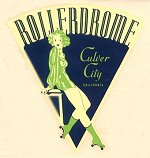 |
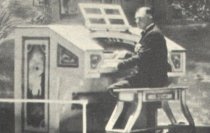
3/6 Wood in the Rollerdrome, Culver |
|
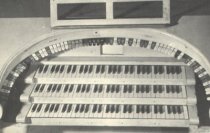
City CA |
After the arrival of "talkies", the William Wood Pipe Organ Company slowly went out of business and "Billy" moved to Los Angeles, California. He installed one of his last pipe organs in the Shrine Roller Rink, adjoining the "Al Malaikah" Shrine Temple in Los Angeles, and later became manager of this rink.
Both the Wood brothers passed away in Los Angeles, William in 1938 and Darwin in 1946. Ed Juster, secretary of the company, passed away in the late 1940's in Portland. Ray Smith, who worked for the firm from its inception, passed on in Hollywood in 1960. He was a fine artist, painter and repairman, and some of his leatherwork is still going strong. An example of Ray's fine artistry can be seen in his paintings on the console and background scenes in the accompanying photo of the 3/6 Rollerdrome installation. The writer has had the pleasure of talking with two other past employees of the company: Glenn Mendenhall of Vancouver, Washington, and Arthur Morey of Portland, Oregon, who have some fine memories of their associations with "Billy" and his pipe organs.
Two fine examples of Wood church organs were installed in Bethlehem Lutheran Church, near East 39th and Sandy Boulevard, Portland, and Saint Mark's Episcopal Church, at Northwest 21st and Marshall. The 4/13 "band" organ that was installed in the Oaks Roller Rink has been replaced with the 4/18 WurliTzer (Opus 1380 - of Oliver Wallace, "Bobby" Burns, and Dow LeRoy fame) from the Broadway Theatre in Portland.
Unfortunately, there is no known complete listing of all the organs built by the company. The list available via the link above is only partially complete. No "Opus" numbers were ever kept at the factory.
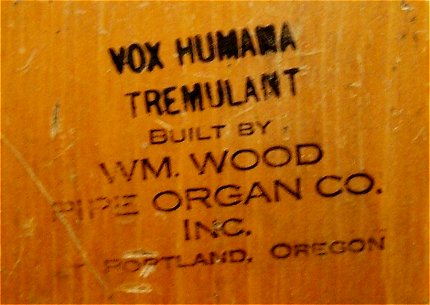
The William Wood Company often stamped various components in their instruments.

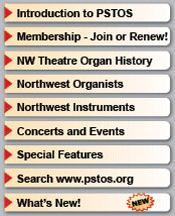

![]() Partial Wood opus list
Partial Wood opus list





